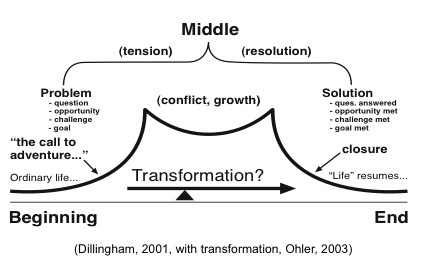Storyboards
Storyboards are a series of frames with drawings and words from a script. Visually, they resemble a comic book. The art in a storyboard is usually rough pencils, but it can be full-color art, 3-D figures (like
HyperReal®), photography, or a combination of two or more of these.
After the script is written for a given commercial, film, or TV show, storyboards are the next step.
Storyboards are most often used in film and television as the first step to illustrate a visually complex scene and attempt to conceptualize its workings.
After the storyboard, the next step is producing an animatic. The artwork from the storyboard is rarely used to produce the final animatic, as it is usually either too rough or not prepared for easy animation.
Check out a sample storyboard, courtesy of
BrainForest Digital, by clicking on the magnifying glass.
Animatic Production
Animatics are produced in a variety of ways.
Animatic production started in a very low-tech manner - they were produced by filming or taping storyboards, then an editor would edit the footage to an audio track. These animatics would seem crude by today's standards, but people were able to do some remarkable work with just paper. Some companies still hang on to these same old techniques, unwilling (or unable) to move to the next generation of production.
Some animatic clients choose to test their commercials or film using photographs or video that may or may not have originally been shot for something else. An animatic based around photographs is called a Photomatic. An animatic based around repurposed video is called a Videomatic or a Rip-o-matic.
Today, some animatic companies have also developed their own computer-generated 2D and 3D art to use in their animatics. Some 3D figures look so realistic that the expense of photographing models for testing purposes has become a thing of the past.
For 3D art, animatic companies use a variety of 3D programs to generate life-like figures. Some have even gone so far as to develop proprietary techniques, such as
HyperReal®.
Producing an Animatic - Start to Finish
Since computer production is the method most used in the industry today, let's do a quick overview on how a typical animatic is produced using a computer.
To illustrate the process, we'll use this scene of a man painting a boat. We start by producing rough artwork to illustrate the composition of the scene and figure out what elements will be needed.
Then, the artwork must be re-drawn from the storyboard or rough images, so that it can be animated. This means every piece that will move independently must be separated.
Next, the artwork must be digitized, or put into a format that a computer can understand. Some artists create their artwork digitally using drawing tablets, while others prefer to work on paper and scan their drawings in.
Once the artwork is digitized, the tasks of coloring and cleaning begin. Cleaning means getting rid of the "dirt" that comes with a scanned image and completing unconnected lines. When it comes to coloring, a computer does it much better and faster.
Finally, with the artwork drawn, digitized, cleaned and colored, we're ready to animate. It's interesting to note that 3D animatic processes, such as
HyperReal®, eliminate these first steps, because everything is already created digitally within the computer at the storyboard stage.
The computer is able to animate using a concept called tweening. Basically, the animator specifies an object's spatial starting point and ending point (and any other points in the middle), and the computer automatically fills in the frames in-between with gradual motion. This technique is essentially the same technique used to create finished animation.
While the animation is being produced, a rough soundtrack is usually added to establish timing for dialogue and make sure everything fits within the alloted time. The final soundtrack, including all of the voice-overs and music, is usually added last, and some final tweaks are made to the animation so that everything is properly synchronized.
The final animatic is then posted to the Internet, or shipped to the destination where it will be screened for a
focus group.

